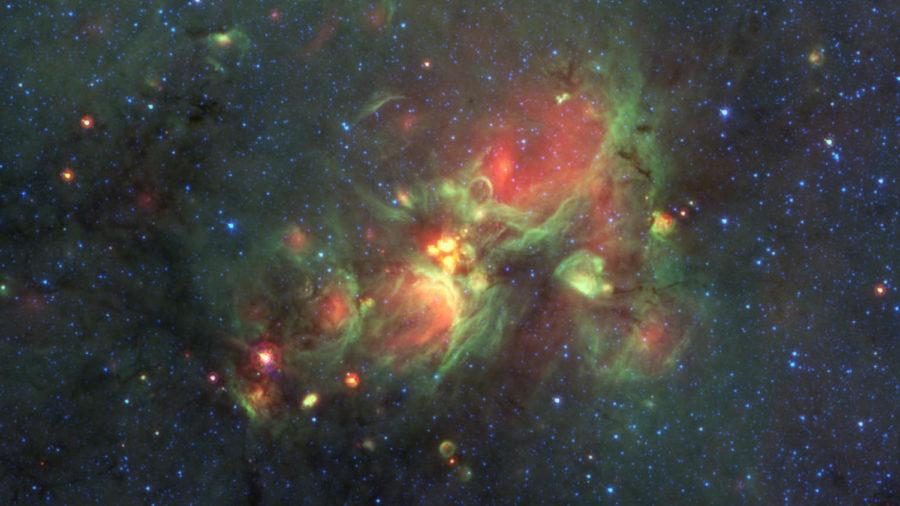Yellowballs serve as missing link between birth of star, colorful bubbles
Citizen scientists helped identify and tag the “yellowballs” in this image, created by Spitzer Space Telescope. ISU professor Charles Kerton works on the Milky Way Project with a team of 35,000 citizen scientists to map star formations.
February 4, 2015
A smile swelled across Charles Kerton’s face as he contemplated what he believes to be the most satisfying thing about the Milky Way Project.
“The serendipity of it all is more than I could’ve asked for.”
Kerton, an associate professor of physics and astronomy, has been working rigorously as a member of the Milky Way Project since it’s establishment in 2010. The Milky Way Project is an online network consisting of around 35,000 volunteers who come together to assist in the mapping of massive star formations in the Milky Way Galaxy.
The volunteers are more accurately known as “citizen scientists”. There are no requirements to become a citizen scientist. The only thing that is demanded is the desire to help.
“It’s interesting because they’re clearly not looking for fame,” Kerton said, “I believe they participate because they’re contributing to a real science project. It’s a mixture [of] someone who has a hobby, but also someone who wants to contribute. It’s a very satisfying feeling.”
It was this kind of participation that led to the discovery of “yellowballs”.
Yellowballs were detected shortly after the project began. Citizen scientists kept asking the question, “What are these yellow, glowing balls?”
Kerton and his team of scientists are in charge of interpreting the raw data coming in from the citizen scientists. After years of research, the team came to a conclusion about the phenomenon that is yellowballs.
“To put it simply, yellowballs are a stage that massive stars go through after they’re formed. It’s the heating of gas and dust that surround the newly formed star, and what we see is the infrared admission and the heat that is being admitted by the dust,” Kerton said. “Because these stars are so big, bigger than our own galaxy, to be exact, that means the region that they form in is also very big and bright.”
According to Astronomy Now, “citizen scientists have identified more than 900 of these compact yellow features.”
As a result of the discovery of yellowballs, astronomists now have another way to detect the formation of stars. Discoveries like these come around whenever a survey such as the Milky Way Project runs.
“The volunteers started chatting about the yellow balls they kept seeing in the images of our galaxy and this brought the features to our attention,” said Grace Wolf-Chase of the Adler Planetarium in Chicago in a NASA press release.
Kerton said studies like the Milky Way Project can serve to tie up loose ends in other studies as well. According to Business Insider, the yellowballs are a “missing link between the birth of a star and the green and red bubbles they produce”. These accidental findings really bring things full circle and serves to be multi-faceted.
In the beginning of the project, the goal was to map at least 85 percent of the Milky Way. Kerton said this goal has definitely been met. Not only have they met their original goal, but they have also managed to publish four other publications as a result of the survey, according to Astronomy Now.
The concept of citizen scientists is not always sunshine and daisies. Kerton explains how sometimes, you get a malicious volunteer in the batch who maps things incorrectly for who knows what reason. Luckily, it is pretty easy to detect strange outliers so situations like that never become a long-lasting problem.
“The unexpected discoveries have been the most satisfying aspect of the Milky Way Project,” Kerton said, “The fact that this wasn’t something designed in the project, it was something the volunteers discovered on their own. Now that is satisfying.”







